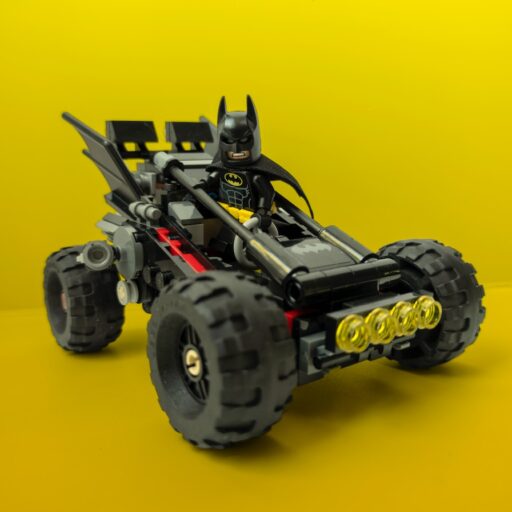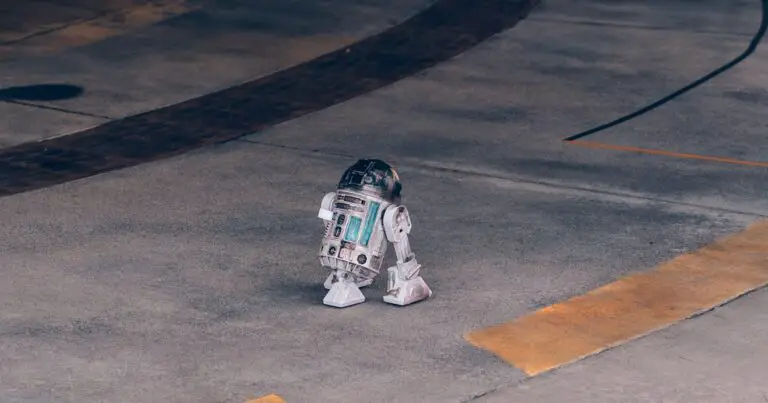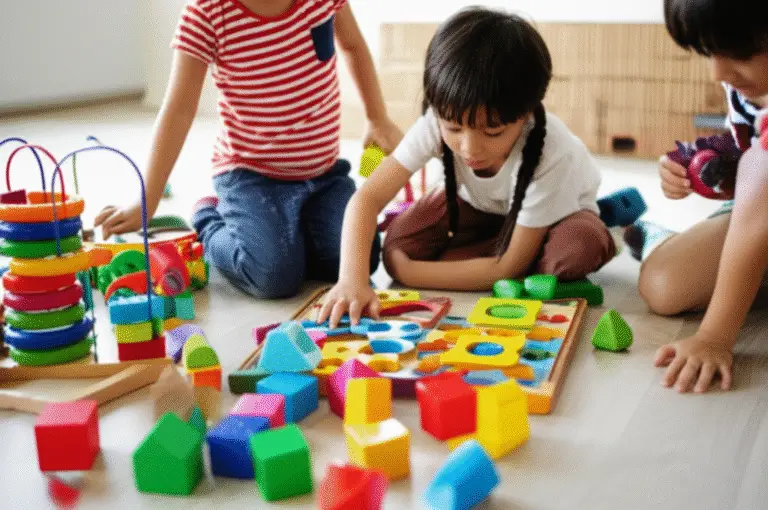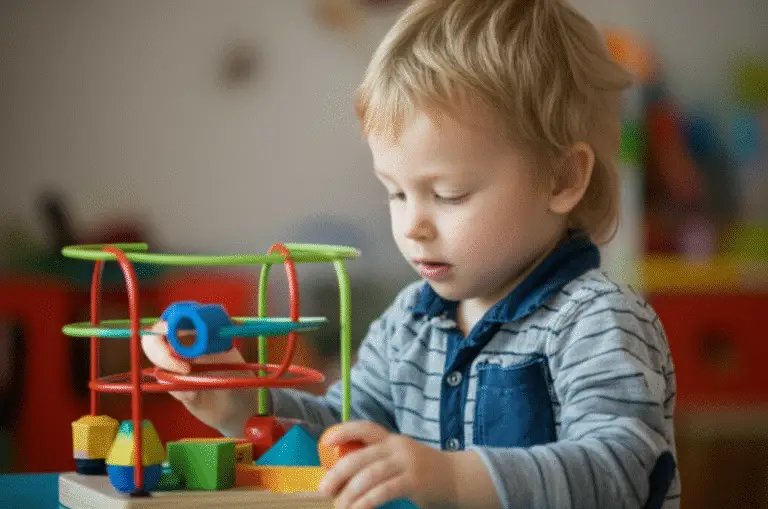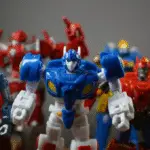Support our educational content for free when you purchase through links on our site. Learn more
12 Toy Brands with Educational Products That Spark Genius in 2025 🚀
Imagine your child building a robot one day and exploring the wonders of nature the next—all while having a blast! At Toy Brands™, we’ve tested and loved dozens of educational toys, and we’re here to reveal the 12 top toy brands that truly combine fun with learning. From timeless wooden classics to cutting-edge tech hybrids, these brands don’t just entertain—they unlock potential, nurture creativity, and set the stage for lifelong success.
Did you know that kids who engage regularly with educational toys develop stronger problem-solving skills and higher creativity? (Source: American Academy of Pediatrics) Stick around as we dive deep into the best brands, share insider tips, and reveal some surprising family favorites and fails. Ready to find the perfect educational toy that fits your child’s unique spark? Let’s go!
Key Takeaways
- Educational toys boost cognitive, social, and motor skills through purposeful, age-appropriate play.
- Top brands like LEGO, Melissa & Doug, and Hape offer durable, engaging, and often eco-friendly options.
- Tech-forward brands like Osmo and LeapFrog blend screen time with hands-on learning for balanced development.
- Beware of flashy “educational” toys that lack substance—look for clear learning goals and open-ended play.
- Parental involvement amplifies learning—playing together turns toys into powerful teaching tools.
- Stay ahead with emerging trends like AR, coding kits, and subscription boxes from KiwiCo.
👉 Shop Educational Toys & STEM Favorites:
Table of Contents
- ⚡️ Quick Tips and Facts: Your Educational Toy Cheat Sheet!
- 🕰️ The Playful Path to Knowledge: A Brief History of Educational Toys
- 🧠 Why Educational Toys Are More Than Just Fun & Games: Unlocking Potential!
- 🧐 What Makes a Toy Truly “Educational”? Our Expert Checklist!
- 🌟 Top Toy Brands That Master the Art of Educational Play!
- LEGO: Building Minds, One Brick at a Time 🧱
- Melissa & Doug: Classic Play, Timeless Learning 🌳
- Fisher-Price: Nurturing Little Learners from Day One 👶
- VTech: Tech-Savvy Toys for Curious Kids 🤖
- LeapFrog: Where Learning Jumps Off the Page! 🐸
- Osmo: Blending Digital Fun with Hands-On Learning 📱
- Magna-Tiles & Connetix: Magnetic Magic for STEM Superstars ✨
- Hape: Eco-Friendly Fun, Globally Inspired Learning 🌍
- Learning Resources: Classroom-Quality Play for Every Home 📚
- National Geographic: Exploring the World Through Play 🔭
- KiwiCo: Subscription Boxes That Spark Innovation 🧪
- ThinkFun & SmartGames: Puzzles That Power Up Problem-Solving Skills 🤔
- 🎯 Beyond the Brand: How to Choose the RIGHT Educational Toy for YOUR Child
- ⚠️ The Pitfalls of “Educational” Toys: What to Watch Out For!
- 💡 Maximizing Learning: Tips for Parents and Educators to Boost Playtime Impact
- 🚀 The Future of Play: Emerging Trends in Educational Toys You Need to Know!
- 👨👩👧👦 Our Family’s Favorites & Fails: Real-Life Anecdotes from the Toy Brands™ Team!
- 🎉 Conclusion: Play Smart, Learn Big!
- 🔗 Recommended Links: Dive Deeper into Educational Play!
- ❓ FAQ: Your Burning Questions About Educational Toys, Answered!
- 📚 Reference Links: Our Sources for Smart Play!
⚡️ Quick Tips and Facts: Your Educational Toy Cheat Sheet!
Welcome to the ultimate playground of knowledge! At Toy Brands™, we’ve gathered the best tips and facts to help you navigate the vibrant world of educational toys. Whether you’re a parent, grandparent, or educator, here’s what you need to know before diving in:
- ✅ Educational toys boost cognitive, social, and motor skills — they’re not just fun, they’re brain fuel!
- ✅ Look for toys that promote STEM learning, creativity, and problem-solving.
- ✅ Age-appropriateness is key: a toy that’s too simple or too complex can frustrate rather than engage.
- ✅ Sustainability matters: brands like Hape use eco-friendly materials that teach kids to care for the planet.
- ✅ Open-ended play toys (think LEGO or Melissa & Doug) encourage imagination and adaptability.
- ✅ Digital and physical hybrid toys (like Osmo) blend screen time with hands-on learning.
- ✅ Beware of “educational” toys that are just flashy gadgets with little substance.
- ✅ Parental involvement can double the learning impact — play together, chat about what they’re discovering!
Curious about which brands really deliver on these promises? Stick with us as we explore the top contenders and insider tips to make your next toy purchase a slam dunk! 🎯
🕰️ The Playful Path to Knowledge: A Brief History of Educational Toys
Before we geek out on today’s hottest brands, let’s rewind the clock. Educational toys have been around for centuries, evolving alongside our understanding of child development.
- Early 19th Century: Froebel’s Kindergarten introduced “gifts” — simple blocks and shapes designed to teach children about form and order.
- Early 20th Century: Montessori schools popularized hands-on learning tools like bead chains and puzzles.
- Mid-20th Century: The rise of Fisher-Price and LEGO brought mass-produced, durable toys that combined fun with learning.
- 21st Century: The digital revolution introduced interactive toys like LeapFrog and VTech, blending technology with education.
This rich history shows us that educational toys aren’t a fad — they’re a fundamental part of how kids learn through play. And today’s brands build on this legacy with innovative designs and materials that meet modern families’ needs.
🧠 Why Educational Toys Are More Than Just Fun & Games: Unlocking Potential!
We all want our kids to have fun, but educational toys do so much more. Here’s why they’re worth the investment:
- Cognitive Development: Toys that challenge memory, logic, and reasoning (think puzzles, building sets) help develop critical thinking.
- Language Skills: Storytelling toys and interactive devices expand vocabulary and communication.
- Motor Skills: Manipulative toys like blocks and art kits enhance fine motor coordination.
- Social-Emotional Growth: Role-play sets (Melissa & Doug’s grocery store, anyone?) teach empathy and cooperation.
- STEM Foundations: Toys that introduce science, technology, engineering, and math concepts early on set kids up for future success.
At Toy Brands™, we’ve seen firsthand how the right toy can spark a lifelong love of learning — and keep kids happily engaged for hours. It’s like planting seeds in a garden of curiosity!
🧐 What Makes a Toy Truly “Educational”? Our Expert Checklist!
Not every toy with a “learning” label lives up to the hype. Here’s how we separate the wheat from the chaff:
- Purposeful Design: Does the toy have clear learning goals? (e.g., shape recognition, counting, problem-solving)
- Age Appropriateness: Is it challenging but not frustrating for the target age group?
- Open-Ended Play: Can the toy be used in multiple ways to encourage creativity?
- Durability & Safety: Is it made from non-toxic, sturdy materials?
- Engagement Factor: Does it hold kids’ attention without relying solely on flashy lights or sounds?
- Parental/Teacher Support: Are there guides or activities to extend learning?
- Inclusivity: Does it cater to diverse learning styles and abilities?
When a toy ticks most or all of these boxes, it’s a winner in our book! For more on choosing smart toys, check out our Educational Toys category.
🌟 Top Toy Brands That Master the Art of Educational Play!
Ready to meet the champions of educational toys? We’ve rated each brand on Design, Functionality, Educational Value, Durability, and Parent/Kid Satisfaction — all on a 1-10 scale. Let’s dive in!
1. LEGO: Building Minds, One Brick at a Time 🧱
| Aspect | Rating (1-10) |
|---|---|
| Design | 9 |
| Functionality | 10 |
| Educational Value | 9 |
| Durability | 10 |
| Parent/Kid Satisfaction | 10 |
Why LEGO Rocks:
LEGO is the gold standard for building blocks, combining creativity with STEM learning. From simple Duplo sets for toddlers to complex Technic kits for older kids, LEGO encourages spatial reasoning, engineering concepts, and fine motor skills. Plus, the endless ways to build mean kids never get bored.
Our Experience:
Our Toy Brands™ kids have spent countless hours building everything from castles to robots. The satisfaction of seeing their creations come alive is priceless, and parents love the screen-free engagement.
Drawbacks:
- Small pieces can be a choking hazard for under 3s.
- Can get pricey for larger sets.
Pro Tip: Combine LEGO with themed kits like LEGO Education for classroom-level learning.
👉 CHECK PRICE on:
2. Melissa & Doug: Classic Play, Timeless Learning 🌳
| Aspect | Rating (1-10) |
|---|---|
| Design | 8 |
| Functionality | 8 |
| Educational Value | 9 |
| Durability | 9 |
| Parent/Kid Satisfaction | 9 |
Why Melissa & Doug Shines:
Known for their wooden toys and open-ended play sets, Melissa & Doug focus on fostering imagination and practical life skills. Their “Skills at Play™” line supports developmental milestones from toddlerhood through elementary years.
Our Experience:
We adore their play food sets and pretend grocery stores — perfect for role-playing and social skills. The quality wood and vibrant colors stand up to rough play, and parents appreciate the non-toxic finishes.
Drawbacks:
- Some sets have many small parts.
- Not as tech-forward as some competitors.
Pro Tip: Pair their toys with real-life activities like cooking or shopping to deepen learning.
👉 CHECK PRICE on:
3. Fisher-Price: Nurturing Little Learners from Day One 👶
| Aspect | Rating (1-10) |
|---|---|
| Design | 8 |
| Functionality | 9 |
| Educational Value | 8 |
| Durability | 8 |
| Parent/Kid Satisfaction | 9 |
Why Fisher-Price Works:
Fisher-Price specializes in infant and toddler toys that stimulate sensory and motor development. Their Laugh & Learn series introduces letters, numbers, and songs in an engaging way.
Our Experience:
Our youngest testers loved the interactive features that respond to touch and sound. Parents appreciate the durability and ease of cleaning.
Drawbacks:
- Some toys rely heavily on batteries.
- Limited appeal beyond toddler years.
Pro Tip: Use Fisher-Price toys as a stepping stone to more complex STEM toys later.
👉 CHECK PRICE on:
4. VTech: Tech-Savvy Toys for Curious Kids 🤖
| Aspect | Rating (1-10) |
|---|---|
| Design | 8 |
| Functionality | 9 |
| Educational Value | 8 |
| Durability | 7 |
| Parent/Kid Satisfaction | 8 |
Why VTech Stands Out:
VTech’s electronic toys blend learning with technology, offering interactive tablets, learning laptops, and more. Their products focus on language, math, and music skills.
Our Experience:
Kids love the bright screens and interactive games, while parents appreciate the educational content. However, some toys feel less durable over time.
Drawbacks:
- Screen time concerns for some parents.
- Battery dependency.
Pro Tip: Limit sessions and combine with physical play for balance.
👉 CHECK PRICE on:
5. LeapFrog: Where Learning Jumps Off the Page! 🐸
| Aspect | Rating (1-10) |
|---|---|
| Design | 8 |
| Functionality | 9 |
| Educational Value | 9 |
| Durability | 8 |
| Parent/Kid Satisfaction | 9 |
Why LeapFrog Excels:
LeapFrog’s interactive books and tablets are designed to teach reading, math, and critical thinking through engaging stories and games.
Our Experience:
Our testers loved the LeapStart series for its interactive pages and audio feedback. Parents like the educational depth and durability.
Drawbacks:
- Limited appeal for older kids.
- Some products can be pricey.
Pro Tip: Use LeapFrog as a supplement to traditional reading and play.
👉 CHECK PRICE on:
6. Osmo: Blending Digital Fun with Hands-On Learning 📱
| Aspect | Rating (1-10) |
|---|---|
| Design | 9 |
| Functionality | 9 |
| Educational Value | 9 |
| Durability | 8 |
| Parent/Kid Satisfaction | 9 |
Why Osmo is a Game-Changer:
Osmo merges physical play with tablet apps, creating interactive experiences that teach math, spelling, coding, and creativity.
Our Experience:
Our Toy Brands™ kids were hooked on the tangible pieces combined with digital feedback. Parents love the balance of screen time and hands-on play.
Drawbacks:
- Requires an iPad or Fire tablet.
- Initial setup can be tricky for some.
Pro Tip: Pair Osmo with offline activities to reinforce concepts.
👉 CHECK PRICE on:
7. Magna-Tiles & Connetix: Magnetic Magic for STEM Superstars ✨
| Aspect | Rating (1-10) |
|---|---|
| Design | 9 |
| Functionality | 10 |
| Educational Value | 9 |
| Durability | 9 |
| Parent/Kid Satisfaction | 10 |
Why Magna-Tiles & Connetix Rule:
These magnetic building tiles encourage spatial reasoning, geometry, and creativity. Their satisfying click and endless configurations keep kids engaged.
Our Experience:
Our testers loved building 3D structures, and parents appreciate the durability and open-ended play. Connetix tiles are a newer, premium alternative with stronger magnets.
Drawbacks:
- Can be pricey for large sets.
- Small pieces not suitable for toddlers.
Pro Tip: Combine with LEGO for mixed-media STEM play.
👉 CHECK PRICE on:
8. Hape: Eco-Friendly Fun, Globally Inspired Learning 🌍
| Aspect | Rating (1-10) |
|---|---|
| Design | 9 |
| Functionality | 9 |
| Educational Value | 9 |
| Durability | 9 |
| Parent/Kid Satisfaction | 9 |
Why Hape Stands Out:
Hape is a leader in sustainable, wooden educational toys used in over 5,000 schools worldwide. Their award-winning designs combine STEM concepts with cultural learning.
Our Experience:
We love their Quadrilla marble runs and Green Planet Explorer series for teaching physics and environmental awareness. Parents rave about the quality and safety.
Drawbacks:
- Wooden toys can be heavier and pricier.
- Some sets require adult assembly.
Pro Tip: Use Hape toys to introduce global cultures and eco-consciousness alongside STEM.
👉 CHECK PRICE on:
9. Learning Resources: Classroom-Quality Play for Every Home 📚
| Aspect | Rating (1-10) |
|---|---|
| Design | 8 |
| Functionality | 9 |
| Educational Value | 9 |
| Durability | 8 |
| Parent/Kid Satisfaction | 8 |
Why Learning Resources is Trusted:
Designed with educators in mind, Learning Resources offers toys that bring classroom-quality STEM and math concepts home.
Our Experience:
Their fraction towers and coding kits are favorites for hands-on learning. Parents appreciate the clear educational goals.
Drawbacks:
- Some toys are more “academic” and less playful.
- May require adult guidance.
Pro Tip: Use alongside school curriculum for reinforcement.
👉 CHECK PRICE on:
10. National Geographic: Exploring the World Through Play 🔭
| Aspect | Rating (1-10) |
|---|---|
| Design | 8 |
| Functionality | 8 |
| Educational Value | 9 |
| Durability | 7 |
| Parent/Kid Satisfaction | 8 |
Why National Geographic Inspires:
Their science kits and exploration toys encourage curiosity about nature, geography, and biology.
Our Experience:
Kids love the hands-on experiments and outdoor exploration gear. Parents like the educational depth and real-world connection.
Drawbacks:
- Kits can be limited in reuse value.
- Some require adult supervision.
Pro Tip: Pair kits with outdoor adventures for maximum impact.
👉 CHECK PRICE on:
11. KiwiCo: Subscription Boxes That Spark Innovation 🧪
| Aspect | Rating (1-10) |
|---|---|
| Design | 9 |
| Functionality | 9 |
| Educational Value | 10 |
| Durability | 8 |
| Parent/Kid Satisfaction | 9 |
Why KiwiCo is a Hit:
KiwiCo’s monthly STEM and art project boxes deliver hands-on experiments and crafts that grow with your child’s age and interests.
Our Experience:
Our Toy Brands™ families love the surprise factor and the detailed instructions that make science fun and accessible.
Drawbacks:
- Subscription commitment required.
- Some projects need extra household supplies.
Pro Tip: Use KiwiCo boxes as a regular family activity to build curiosity and confidence.
👉 CHECK PRICE on:
12. ThinkFun & SmartGames: Puzzles That Power Up Problem-Solving Skills 🤔
| Aspect | Rating (1-10) |
|---|---|
| Design | 8 |
| Functionality | 9 |
| Educational Value | 9 |
| Durability | 8 |
| Parent/Kid Satisfaction | 9 |
Why ThinkFun & SmartGames Are Brilliant:
These brands specialize in logic puzzles and brainteasers that develop critical thinking and spatial reasoning.
Our Experience:
Our testers enjoy the challenge and variety, and parents appreciate the screen-free mental workout.
Drawbacks:
- Can be frustrating for younger kids without guidance.
- Some puzzles have limited replay value.
Pro Tip: Use as a family challenge or classroom supplement.
👉 CHECK PRICE on:
🎯 Beyond the Brand: How to Choose the RIGHT Educational Toy for YOUR Child
Choosing the perfect educational toy can feel like navigating a jungle of options. Here’s our step-by-step guide to help you pick a winner:
-
Assess Your Child’s Interests and Learning Style
- Is your kid a builder, a storyteller, or a tech whiz?
- Visual, auditory, or kinesthetic learner?
-
Consider Age and Developmental Stage
- Check manufacturer age recommendations.
- Look for toys that challenge but don’t overwhelm.
-
Set Learning Goals
- What skills do you want to nurture? STEM, language, social?
-
Check for Safety and Quality
- Non-toxic materials, no small parts for young kids.
-
Read Reviews and Try Before You Buy
- Our Toy Brands™ community reviews are a great resource!
-
Balance Screen Time and Hands-On Play
- Combine physical toys with digital learning tools like Osmo or LeapFrog.
-
Budget Wisely
- Invest in versatile toys that grow with your child.
Remember, the best educational toy is one that sparks joy and curiosity — not just a checklist item! For more guidance, visit our STEM Toys and Electronic Toys categories.
⚠️ The Pitfalls of “Educational” Toys: What to Watch Out For!
Not all that glitters is gold — and not every “educational” toy delivers on its promise. Here are some red flags:
- ❌ Overly flashy toys that rely on lights and sounds without substance.
- ❌ Toys with vague or no clear learning objectives.
- ❌ Products that are too complex or too simple for your child’s age.
- ❌ Poorly made toys that break easily or contain unsafe materials.
- ❌ Toys that encourage passive consumption rather than active engagement.
We’ve learned from experience that a toy’s educational value comes from quality design and thoughtful play, not gimmicks. Always check for certifications like ASTM or EN71 for safety.
💡 Maximizing Learning: Tips for Parents and Educators to Boost Playtime Impact
Want to turn playtime into a powerhouse of learning? Here’s how:
- Join the Fun: Play alongside your child to model curiosity and problem-solving.
- Ask Open-Ended Questions: “What do you think will happen if…?” or “How did you build that?”
- Rotate Toys: Keep things fresh by cycling through different types of educational toys.
- Create Themed Play Zones: STEM corner, art station, reading nook — make learning immersive.
- Encourage Storytelling: Use toys like Melissa & Doug’s pretend play sets to build language skills.
- Limit Screen Time: Balance digital toys with hands-on activities.
- Celebrate Effort, Not Just Results: Praise creativity and persistence.
These simple strategies can transform any toy into a learning superstar!
🚀 The Future of Play: Emerging Trends in Educational Toys You Need to Know!
The world of educational toys is evolving fast. Here’s what’s on the horizon:
- Augmented Reality (AR) and Mixed Reality: Toys that blend real and virtual worlds for immersive learning.
- Coding and Robotics: More accessible kits for younger kids to learn programming basics.
- Sustainability Focus: Eco-friendly materials and toys that teach environmental stewardship (hello, Hape’s Green Planet Explorer!).
- Personalized Learning: AI-driven toys that adapt to a child’s pace and style.
- STEAM Integration: Adding Art to STEM for a holistic approach.
- Subscription Models: Like KiwiCo, delivering fresh, curated projects monthly.
Staying ahead means embracing innovation while keeping play meaningful and fun.
👨👩👧👦 Our Family’s Favorites & Fails: Real-Life Anecdotes from the Toy Brands™ Team!
We’re not just experts — we’re parents and kids who’ve tested these toys in the trenches!
- Favorite: Our 7-year-old’s obsession with LEGO Technic sets led to hours of focused building and even inspired a mini “engineering club” with neighborhood friends.
- Surprise Hit: The Osmo Genius Kit turned screen time into a creative challenge that even our tech-wary teenager loved.
- Epic Fail: A flashy “educational” tablet that promised language skills but ended up ignored after two days — too much noise, too little substance.
- Heartwarming: Melissa & Doug’s grocery store playset sparked imaginative role-play and family dinners where kids “shopped” and “cooked” together.
- Sustainability Win: Hape’s wooden marble run survived multiple moves and still looks brand new — plus, it’s a conversation starter about caring for the planet.
These stories remind us that the best toy is one that fits your family’s unique rhythm and sparks joy.
🎉 Conclusion: Play Smart, Learn Big!
Wow, what a journey through the world of educational toys! From the timeless creativity of LEGO and Melissa & Doug to the tech-savvy innovations of Osmo and LeapFrog, and the eco-conscious craftsmanship of Hape, we’ve uncovered a treasure trove of options that truly make learning fun and effective.
Here’s the scoop:
- Positives: These top brands offer a fantastic blend of durability, educational value, and engagement. They cater to a wide range of ages and interests, from toddlers exploring shapes with Fisher-Price to budding engineers mastering coding with KiwiCo. Many also emphasize sustainability and open-ended play, which we love.
- Negatives: Some toys can be pricey or require adult involvement, and a few rely heavily on batteries or screens, which might not suit every family’s preferences. Also, watch out for flashy “educational” toys that don’t deliver real learning.
Our confident recommendation? Invest in toys that match your child’s interests and developmental stage, and don’t hesitate to mix classic wooden toys with modern tech hybrids. The right educational toy can spark curiosity, build skills, and create joyful memories — just like we’ve seen in our own Toy Brands™ families.
Remember that the best educational toy isn’t just about the brand or price tag — it’s about engagement, quality, and the magic of discovery. So go ahead, pick a winner, and watch your little learner thrive! 🚀
🔗 Recommended Links: Dive Deeper into Educational Play!
Ready to shop or learn more? Here’s your curated list of links to explore and grab these fantastic educational toys:
-
LEGO Educational Toys:
Amazon | Walmart | LEGO Official Website -
Melissa & Doug Toys:
Amazon | Walmart | Melissa & Doug Official Website -
Fisher-Price Educational Toys:
Amazon | Walmart | Fisher-Price Official Website -
VTech Learning Toys:
Amazon | Walmart | VTech Official Website -
LeapFrog Learning Systems:
Amazon | Walmart | LeapFrog Official Website -
Osmo Interactive Learning:
Amazon | Walmart | Osmo Official Website -
Magna-Tiles & Connetix:
Amazon | Walmart | Magna-Tiles Official Website -
Hape Toys:
Amazon | Walmart | Hape Official Website -
Learning Resources:
Amazon | Walmart | Learning Resources Official Website -
National Geographic Science Kits:
Amazon | Walmart | National Geographic Official Website -
KiwiCo Subscription Boxes:
Amazon | KiwiCo Official Website -
ThinkFun & SmartGames Puzzles:
Amazon | Walmart | ThinkFun Official Website
Recommended Books on Educational Play
- Einstein Never Used Flashcards by Kathy Hirsh-Pasek & Roberta Michnick Golinkoff — a must-read on the science of playful learning.
- The Power of Play by David Elkind — explores why play is essential for development.
- Playful Parenting by Lawrence J. Cohen — practical tips for making playtime meaningful.
❓ FAQ: Your Burning Questions About Educational Toys, Answered!
What are the most popular educational toy brands for kids?
The most popular brands include LEGO, Melissa & Doug, Fisher-Price, VTech, and LeapFrog. These brands have built reputations for combining fun with learning across various age groups and developmental stages. Their toys are widely available, well-reviewed, and backed by decades of experience in child development.
Which toy brands offer STEM-related educational products?
Brands like LEGO Education, KiwiCo, Magna-Tiles, Hape, and Learning Resources specialize in STEM toys. They provide hands-on kits and building sets that teach science, technology, engineering, and math concepts through engaging play. For example, KiwiCo’s subscription boxes deliver age-appropriate STEM projects monthly, while Hape’s Quadrilla marble runs teach physics principles.
How do I choose the best educational toys for my child’s age group?
Start by considering your child’s developmental stage and interests. Look for toys with clear age recommendations and learning goals. For toddlers, sensory and motor skill toys like Fisher-Price’s Laugh & Learn series are ideal. Preschoolers benefit from open-ended play sets like Melissa & Doug’s role-play kits. Older kids thrive with complex building sets like LEGO Technic or coding kits from KiwiCo. Always check for safety and durability.
What are some affordable educational toy brands for budget-conscious parents?
Brands like Melissa & Doug and Learning Resources offer many affordable, high-quality educational toys. Additionally, Fisher-Price provides budget-friendly options for younger children. Consider buying smaller sets or individual components to build collections over time. Subscription boxes like KiwiCo can also be cost-effective by delivering curated projects that grow with your child.
Are there any eco-friendly toy brands that offer educational products?
Absolutely! Hape is a standout brand focusing on sustainable, non-toxic wooden toys. Their Green Planet Explorer series teaches environmental awareness alongside STEM concepts. Melissa & Doug also emphasizes sustainability with many wooden and durable products. Choosing eco-friendly toys supports both your child’s learning and the planet’s health.
Can educational toys really improve a child’s learning and development?
Yes! Research shows that well-designed educational toys can enhance cognitive, motor, language, and social-emotional skills. According to the American Academy of Pediatrics, play is essential for healthy brain development. Educational toys that encourage problem-solving, creativity, and interaction help children build foundational skills that support lifelong learning.
What are some highly-recommended educational toy brands for children with special needs?
Brands like Melissa & Doug and Learning Resources offer toys designed with sensory and developmental needs in mind. For example, tactile puzzles, sensory bins, and adaptive learning tools can support children with autism or developmental delays. LeapFrog and VTech also provide interactive toys that can be customized for different learning paces. Consulting with therapists or educators can help tailor choices.
📚 Reference Links: Our Sources for Smart Play!
- Lakeshore Learning Rewards Program — detailed info on educational materials and rewards.
- Melissa & Doug Official Website — explore their extensive educational toy lines.
- Hape Toys Official Site — discover award-winning sustainable educational toys.
- LEGO Education — STEM-focused building sets and curriculum.
- KiwiCo Official Website — innovative STEM subscription boxes.
- American Academy of Pediatrics on Play — research on play and child development.
- National Geographic Shop — science kits and exploration toys.
- ThinkFun Official Website — logic and puzzle games for critical thinking.
For more on the best wooden toys and educational products, check out Hape Toys Top Brand, Best wooden toys for kids, educational toys.
